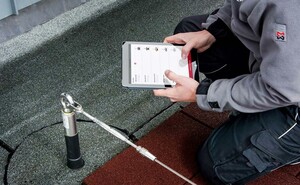- General terms
- Fall danger zone
- Falling edge
- Fall arrest for individuals
- Working alone
- General type approval
- Anchorage device
- Anchorage option
- Working on mobile elevating work platforms
- Arresting system
- Fall-through resistant
- Single anchorage point (anchor)
- Familiarisation
- Enclosed space
- Flat roof safety system
- Risk assessment
- Suspension trauma
- Swing fall
- Rescue concept
- Retention system
- Secondary fall arrest system
- Roof safety hook
- Safety and Occupational Health Coordinator (German: "SiGeKo")
- Thermal isolation
- Anchorage device inspections
- Training
- abZ & DIBt
- DGUV - German statutory accident insurance
- Collective protection
- Standards & regulations
- PPE
- Safety systems
- Access Technology
General terms
Anchorage device inspections
Anchorage devices need to be regularly inspected to keep them in a safe working condition. External influences - as well as simple usage - may lead to signs of wear or damage.
Obligation to inspect anchorage devices
The obligation to inspect anchorage devices has its origins in EN 795 which states that anchorage devices must be inspected at least every 12 months.
As a manufacturer of anchorage devices, we have incorporated this specification into our safety instructions – making it binding for all our safety products.
When do the inspections have to be carried out?
Inspections must be carried out at least once a year. Special circumstances may require your anchorage systems to be examined more frequently.
Examples:
- Frequent and intensive usage
- If located near the coast
- If they are partially or completely submerged in water
- In a swimming pool environment
- An an aggressive environment / atmosphere
- etc.
Special events may also lead to your having to inspect your anchorage device outside your normal inspection plan.
Examples:
- After a fall
- After improper usage
- After a lightning strike
- etc.
Who is allowed to inspect anchorage devices?
Anchorage devices must always be inspected by a competent individual. The inspector must also have appropriate knowledge of the product. Proof of this is normally provided through special training sessions held by the manufacturer.
You are allowed to inspect mobile anchorage devices used in the personal protective equipment area after having successfully participated in a seminar in accordance with DGUV Principle 312-906.
For those anchorage devices which are subject to the Construction Products Regulation, a respective certificate of competence can be obtained from the manufacturer of the product. Please refer to our entry on courses to qualify as a “Competent person for ABS Safety systems”
Procedure for carrying out an inspection
An inspection generally consists of a formal check and a visual & functional check.
Formal check
During the course of the formal check, the installation documentation and any previous maintenance documentation is examined. This is aimed at being able to clearly identify the anchorage device in question, to determine whether the product meets the formal criteria and whether it is even possible to inspect it.
Visual & functional check
The visual & functional check provides you with information on what condition your anchorage device is in. Particular attention is paid to rust, deformation and to verifying that the device has been installed according to the installation principles.
Documentation
All the findings and the results of the inspection are recorded in a corresponding maintenance log. This documentation serves as proof for the building operator.
Verification that the device has passed the inspection may be affixed to the specification plate of a lifeline system - although such stickers are not mandatory.
If the building operator has approved usage of the device, the user can take this as confirmation that the device is in an orderly condition. Should the user discover any defects, he/she must immediately stop work in this area and inform the building operator accordingly.
Creating documentation and managing objects and products is really easy, if you use our Lock Book Docu. You can use it free of charge and complete your documentation right there on the construction site using our special app.

